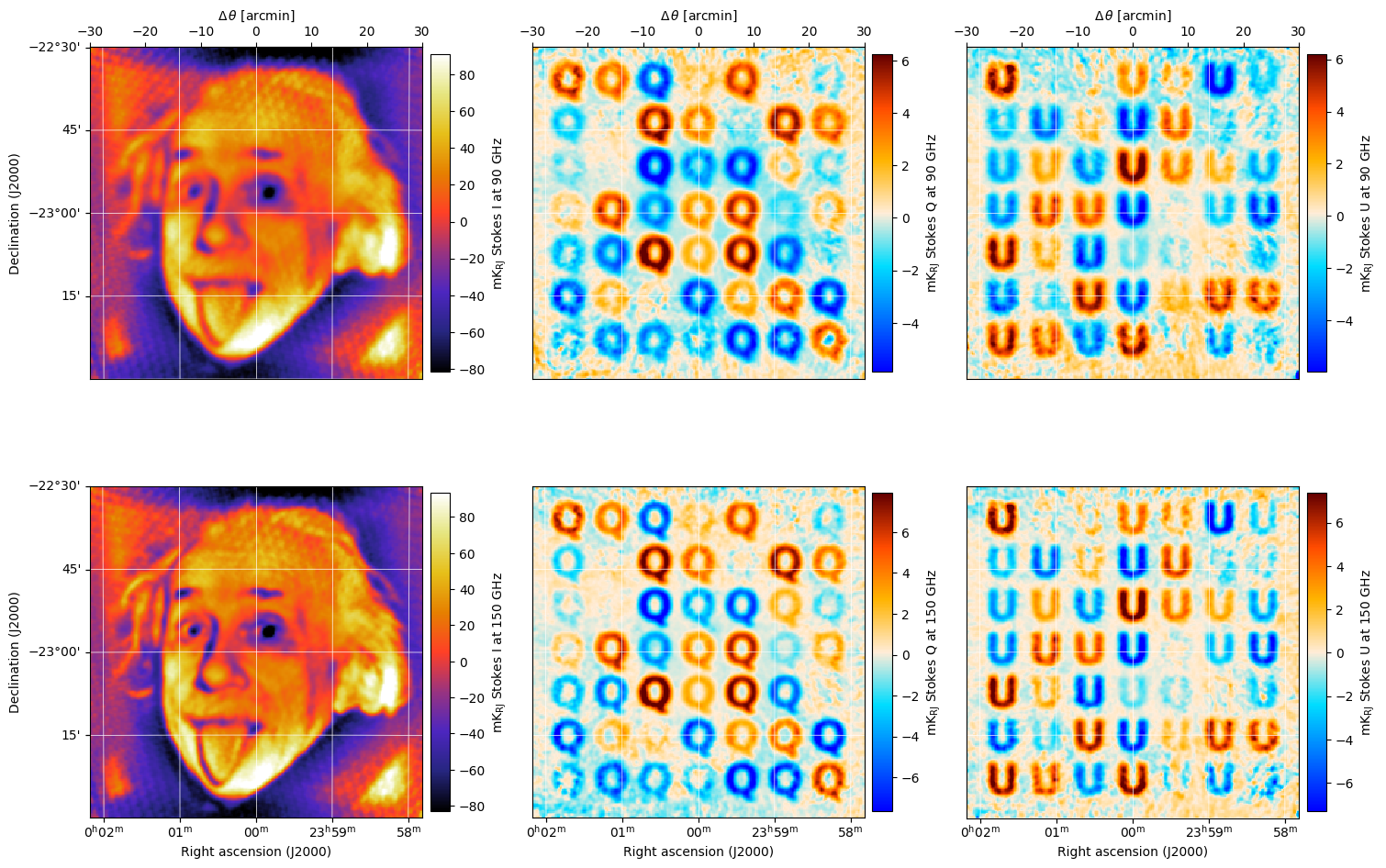Polarized observations¶
This tutorial covers working with polarized instrument and maps, and recovering polarized maps from observations.
We start with a normal instrument, and create two orthogonally polarized copies of each detector by setting polarized: True in the Array config:
[1]:
import maria
from maria.instrument import Band
f090 = Band(
center=90e9, # in Hz
width=20e9, # in Hz
NET_RJ=40e-6, # in K sqrt(s)
knee=1e0, # in Hz
gain_error=5e-2)
f150 = Band(
center=150e9,
width=30e9,
NET_RJ=60e-6,
knee=1e0,
gain_error=5e-2)
array = {"field_of_view": 0.5,
"shape": "circle",
"beam_spacing": 1.5,
"primary_size": 10,
"polarized": True,
"bands": [f090, f150]}
instrument = maria.get_instrument(array=array)
print(instrument.arrays)
n FOV baseline bands polarized
array1 652 0.478° 0 m [f090,f150] True
We can see the resulting polarization footprint in the instrument plot:
[2]:
print(instrument)
instrument.plot()
Instrument(1 array)
├ arrays:
│ n FOV baseline bands polarized
│ array1 652 0.478° 0 m [f090,f150] True
│
└ bands:
name center width η NEP NET_RJ NET_CMB FWHM
0 f090 90 GHz 20 GHz 0.5 5.445 aW√s 40 uK_RJ√s 49.13 uK_CMB√s 1.458’
1 f150 150 GHz 30 GHz 0.5 12.25 aW√s 60 uK_RJ√s 104 uK_CMB√s 0.8748’
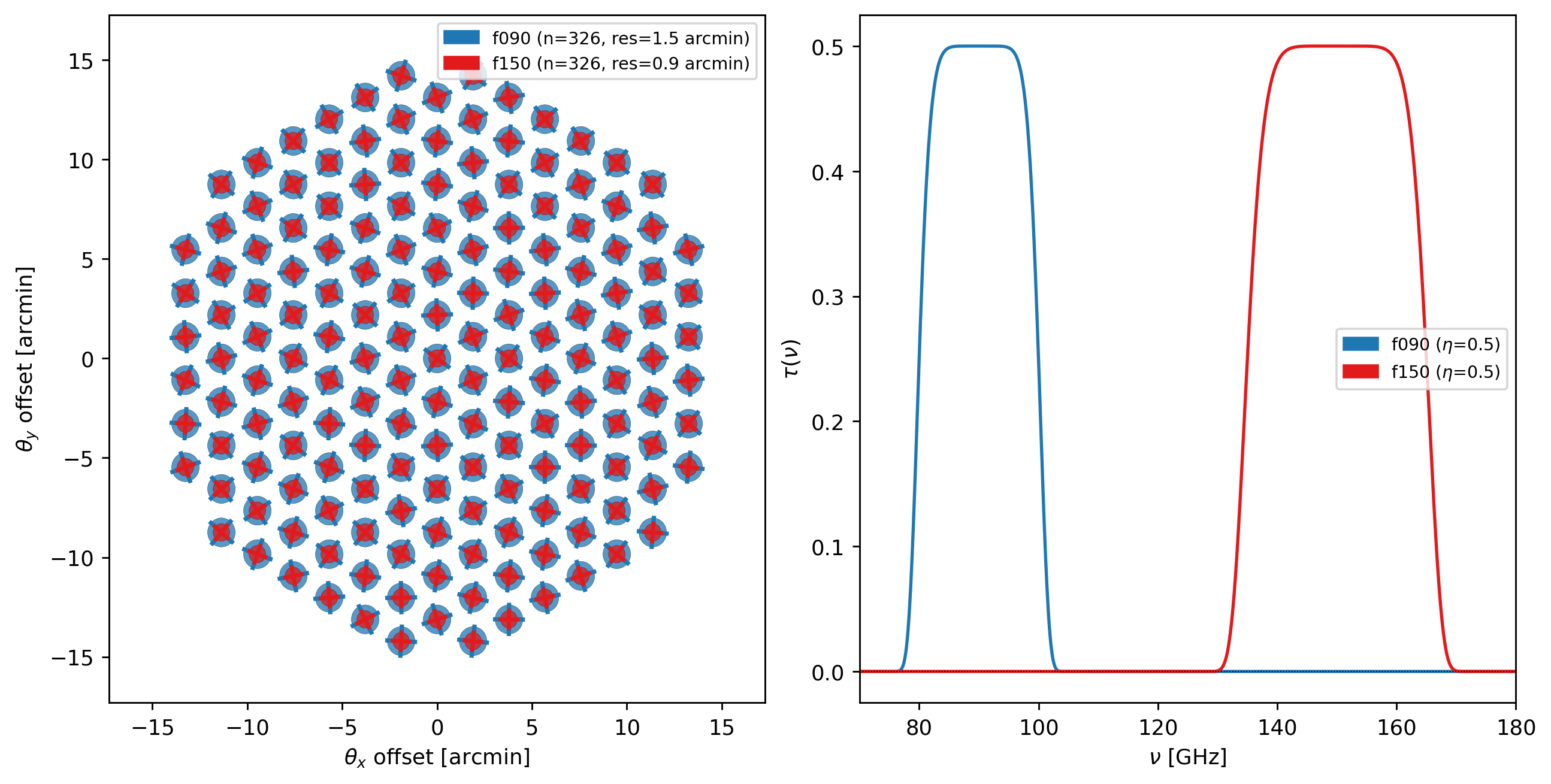
Let’s observe the use the Einstein map, which has a faint polarization signature underneath the unpolarized signal of Einstein’s face. Remember that all maps are five dimensional (stokes, frequency, time, y, x); this map has four channels in the stokes dimensions (the I, Q, U, and V Stokes parameters). We can plot all the channels by giving plot a shaped set of stokes parameters.
[3]:
from maria.io import fetch
input_map = maria.map.load(fetch("maps/einstein.h5"))
input_map.plot(stokes=[["I", "Q"],
["U", "V"]])
2025-11-28 16:58:36.230 INFO: Fetching https://github.com/thomaswmorris/maria-data/raw/master/maps/einstein.h5
Downloading: 100%|████████████████| 931k/931k [00:00<00:00, 41.8MB/s]
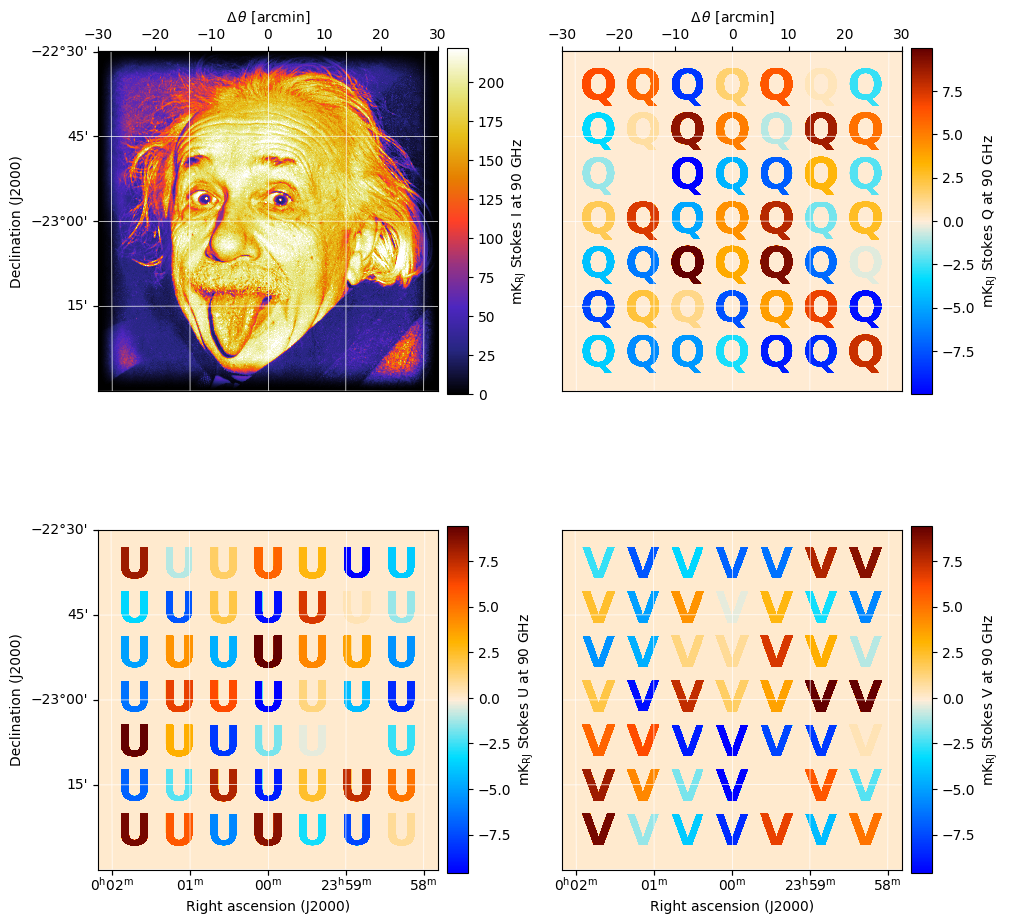
[4]:
from maria import Planner
planner = Planner(target=input_map, site="llano_de_chajnantor", constraints={"el": (60, 90)})
plans = planner.generate_plans(total_duration=900, # in seconds
sample_rate=50) # in Hz
plans[0].plot()
print(plans)
PlanList(1 plans, 900 s):
start_time duration target(ra,dec) center(az,el)
chunk
0 2025-11-28 21:51:09.905 +00:00 900 s (360°, -23°) (95.7°, 62.09°)
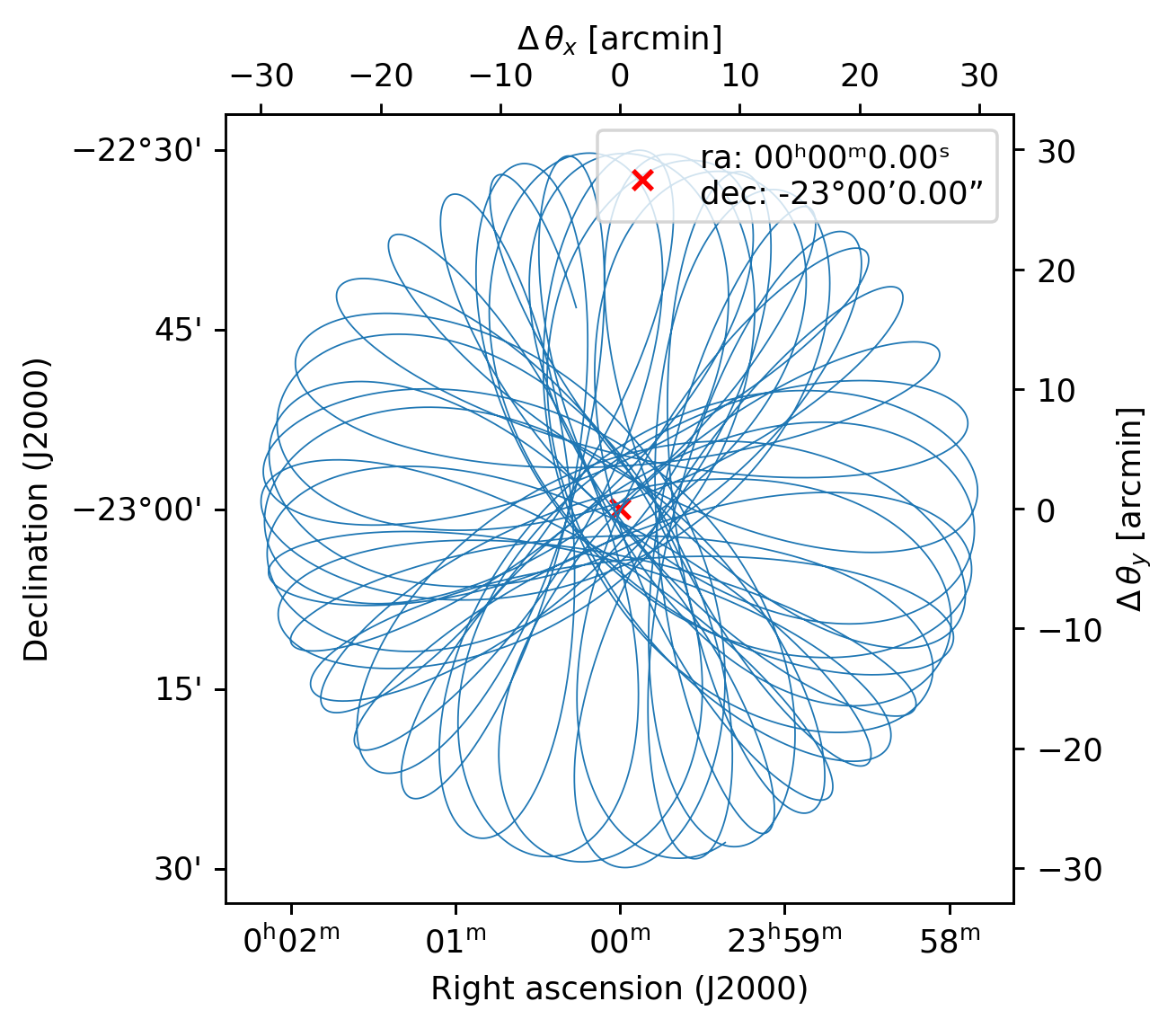
[5]:
sim = maria.Simulation(
instrument,
plans=plans,
site="llano_de_chajnantor",
atmosphere="2d",
atmosphere_kwargs={"weather": {"pwv": 0.5}},
map=input_map
)
print(sim)
Simulation
├ Instrument(1 array)
│ ├ arrays:
│ │ n FOV baseline bands polarized
│ │ array1 652 0.478° 0 m [f090,f150] True
│ │
│ └ bands:
│ name center width η NEP NET_RJ NET_CMB FWHM
│ 0 f090 90 GHz 20 GHz 0.5 5.445 aW√s 40 uK_RJ√s 49.13 uK_CMB√s 1.458’
│ 1 f150 150 GHz 30 GHz 0.5 12.25 aW√s 60 uK_RJ√s 104 uK_CMB√s 0.8748’
├ Site:
│ region: chajnantor
│ timezone: America/Santiago
│ location:
│ longitude: 67°45’17.28” W
│ latitude: 23°01’45.84” S
│ altitude: 5064 m
│ seasonal: True
│ diurnal: True
├ PlanList(1 plans, 900 s):
│ start_time duration target(ra,dec) center(az,el)
│ chunk
│ 0 2025-11-28 21:51:09.905 +00:00 900 s (360°, -23°) (95.7°, 62.09°)
├ '2d'
└ ProjectionMap:
shape(stokes, nu, t, y, x): (4, 1, 1, 685, 685)
stokes: IQUV
nu: [90.] GHz
t: [1.76434911e+09]
z: naive
quantity: rayleigh_jeans_temperature
units: K_RJ
min: -1.000e-02
max: 2.540e-01
rms: 5.754e-02
center:
ra: 00ʰ00ᵐ0.00ˢ
dec: -23°00’0.00”
size(y, x): (1°, 1°)
resolution(y, x): (5.255”, 5.255”)
beam(maj, min, rot): [[[[0. 0. 0.]]]
[[[0. 0. 0.]]]
[[[0. 0. 0.]]]
[[[0. 0. 0.]]]] rad
memory: 30.03 MB
[6]:
tods = sim.run()
print(tods)
tods[0].plot()
2025-11-28 16:58:47.411 INFO: Simulating observation 1 of 1
Constructing atmosphere: 100%|████████████████| 8/8 [00:22<00:00, 2.84s/it]
Generating turbulence: 100%|████████████████| 8/8 [00:01<00:00, 4.29it/s]
Sampling turbulence: 100%|████████████████| 8/8 [00:07<00:00, 1.01it/s]
Computing atmospheric emission: 100%|████████████████| 2/2 [00:02<00:00, 1.17s/it, band=f150]
Sampling map: 100%|████████████████| 2/2 [00:15<00:00, 7.70s/it, band=f150, channel=(0 Hz, inf Hz)]
Generating noise: 100%|████████████████| 2/2 [00:01<00:00, 1.49it/s, band=f150]
2025-11-28 16:59:59.744 INFO: Simulated observation 1 of 1 in 72.32 s
[TOD(shape=(652, 45000), fields=['atmosphere', 'map', 'noise'], units='K_RJ', start=2025-11-28 22:06:09.884 +00:00, duration=900.0s, sample_rate=50.0Hz, metadata={'atmosphere': True, 'sim_time': <Arrow [2025-11-28T16:59:41.803236+00:00]>, 'altitude': 5064.0, 'region': 'chajnantor', 'pwv': 0.5, 'base_temperature': 278.706})]
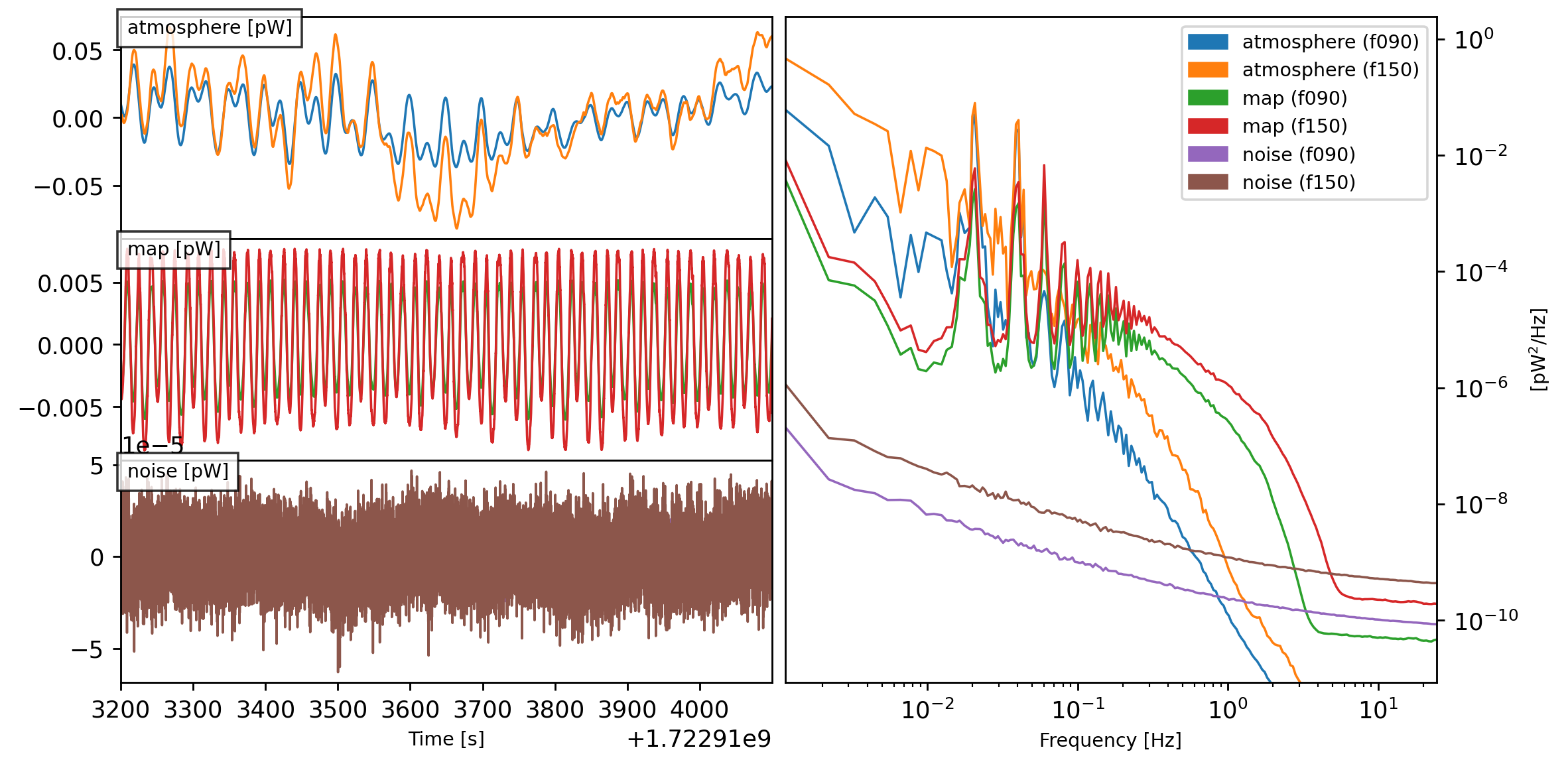
[7]:
from maria.mappers import BinMapper
mapper = BinMapper(
stokes="IQUV",
frame="ra/dec",
resolution=0.25 / 60,
tod_preprocessing={
"remove_spline": {"knot_spacing": 60, "remove_el_gradient": True},
"remove_modes": {"modes_to_remove": 1},
},
map_postprocessing={
"gaussian_filter": {"sigma": 1},
},
units="mK_RJ",
tods=tods,
)
output_map = mapper.run()
print(output_map)
2025-11-28 17:00:11.001 INFO: Inferring center {'ra': '23ʰ59ᵐ59.13ˢ', 'dec': '-22°59’58.86”'} for mapper.
2025-11-28 17:00:11.015 INFO: Inferring mapper width 1.47° for mapper from observation patch.
2025-11-28 17:00:11.016 INFO: Inferring mapper height 1.47° to match supplied width.
Preprocessing TODs: 100%|████████████████| 1/1 [00:02<00:00, 2.22s/it]
Mapping: 100%|██████████| 1/1 [00:07<00:00, 7.10s/it, tod=1/1]
2025-11-28 17:00:20.600 WARNING: No counts for map (stokes=V, nu=90 GHz)
2025-11-28 17:00:20.609 WARNING: No counts for map (stokes=V, nu=150 GHz)
ProjectionMap:
shape(stokes, nu, t, y, x): (4, 2, 1, 352, 352)
stokes: IQUV
nu: [ 90. 150.] GHz
t: [1.76436712e+09]
z: naive
quantity: rayleigh_jeans_temperature
units: mK_RJ
min: -1.134e+02
max: 1.436e+02
rms: nan
center:
ra: 23ʰ59ᵐ59.13ˢ
dec: -22°59’58.86”
size(y, x): (1.467°, 1.467°)
resolution(y, x): (15”, 15”)
beam(maj, min, rot): [[[[1.45801568 1.45801568 0. ]]
[[0.87480941 0.87480941 0. ]]]
[[[1.45801568 1.45801568 0. ]]
[[0.87480941 0.87480941 0. ]]]
[[[1.45801568 1.45801568 0. ]]
[[0.87480941 0.87480941 0. ]]]
[[[1.45801568 1.45801568 0. ]]
[[0.87480941 0.87480941 0. ]]]]’
memory: 15.86 MB
Note that we can’t see any of the circular polarization, since our instrument isn’t sensitive to it.
[8]:
output_map.plot(stokes=["I", "Q", "U"], nu_index=[[0], [1]])
